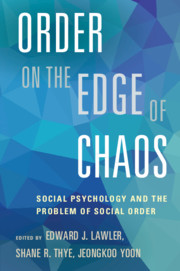Book contents
- Frontmatter
- Contents
- List of Contributors
- Preface
- 1 Social Psychology of Social Order: An Introduction
- 2 The Evolutionary Biology and Sociology of Social Order
- 3 Social Rationality and Weak Solidarity: A Coevolutionary Approach to Social Order
- 4 An Integrative Theory of Action: The Model of Frame Selection
- 5 The Center Cannot Hold: Networks, Echo Chambers, and Polarization
- 6 Social Exchange and Social Order: An Affect Theory Approach
- 7 Institutions, Trust, and Social Order
- 8 Identity Verifi cation and the Social Order
- 9 Identities, Roles, and Social Institutions: An Affect Control Account of Social Order
- 10 The Gender Frame and Social Order
- 11 Status, Power, and Social Order
- 12 Interaction Order: The Making of Social Facts
- 13 The Arts of Together: Social Coordination as Dyadic Achievement
- 14 Dignity as Moral Motivation: The Problem of Social Order Writ Small
- 15 The Legitimacy of Groups and the Mobilization of Resources
- Commentary: Contrasts and Complementarities
- Index
- References
6 - Social Exchange and Social Order: An Affect Theory Approach
Published online by Cambridge University Press: 05 December 2015
- Frontmatter
- Contents
- List of Contributors
- Preface
- 1 Social Psychology of Social Order: An Introduction
- 2 The Evolutionary Biology and Sociology of Social Order
- 3 Social Rationality and Weak Solidarity: A Coevolutionary Approach to Social Order
- 4 An Integrative Theory of Action: The Model of Frame Selection
- 5 The Center Cannot Hold: Networks, Echo Chambers, and Polarization
- 6 Social Exchange and Social Order: An Affect Theory Approach
- 7 Institutions, Trust, and Social Order
- 8 Identity Verifi cation and the Social Order
- 9 Identities, Roles, and Social Institutions: An Affect Control Account of Social Order
- 10 The Gender Frame and Social Order
- 11 Status, Power, and Social Order
- 12 Interaction Order: The Making of Social Facts
- 13 The Arts of Together: Social Coordination as Dyadic Achievement
- 14 Dignity as Moral Motivation: The Problem of Social Order Writ Small
- 15 The Legitimacy of Groups and the Mobilization of Resources
- Commentary: Contrasts and Complementarities
- Index
- References
Summary
Abstract
We theorize how social exchanges at the micro level generate social order at higher or macro levels of analysis. There are two themes in the argument. The first extrapolates an implicit theory of social order found in exchange theorizing, highlighting both its strengths and limitations. A key strength is that it is a relational theory. A key limitation is that it adopts a purely instrumental conception of people and their relations. The second theme is that this strength can be built upon and the limitation mitigated if one considers the emotional byproducts of social exchange. Social exchanges generate emotions; and when people attribute their feelings to social units, they have an impact on their affective sentiments about group ties. Such social unit attributions link social exchange at the micro level to social ties at the macro level. Exchange-based interpersonal ties are transformed into affective person-to-group ties that promote group-oriented behaviors and sacrifices for the collective welfare.
The Hobbesian problem of social order can be recast in terms of two fundamental social ties: person-to-person and person-to-group. The Hobbesian framing posits that problems with forming and sustaining productive person-to-person ties – humans’ avarice and aggression toward one another – make necessary strong person-to-group social ties, designed to control an inherent tendency of person-to-person social interactions to descend into a “war of all against all.” To understand modern manifestations of this Hobbesian problem, both dimensions clearly are important.
The relational ties of people to each other (person-to-person) and their ties to social units (person-to-group) represent distinct types of social bonds (see Prentice, Miller, and Lightdale 1994 for evidence). Person-to-person ties entail micro level social interactions in which people develop bonds with other people; whereas person-to-group ties entail a direct link between people and an encompassing social unit, which could be a small local unit or large more distant organization, community, or even nation state (see Lawler, Thye, and Yoon 2009, 2014). This paper reviews theory and research that specifies how and when person-to-group ties emerge from person-to-person ties, and in particular, the implications this has for the Hobbesian problem of social order.
- Type
- Chapter
- Information
- Order on the Edge of ChaosSocial Psychology and the Problem of Social Order, pp. 105 - 124Publisher: Cambridge University PressPrint publication year: 2015
References
- 3
- Cited by

